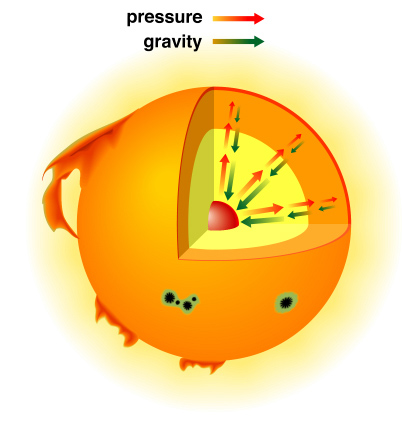The big bang produced only Hydrogen and Helium with trace amounts of Lithium. (For the most part.) This is a problem for star formation because stars need to be "cool" to form and typically you need heavier elements to help the star cool off. This is why:
Gravity pulls mass together. However, as matter gets pulled together it heats up and this heat causes the matter to want to expend again. (See the image above.) In order to form something like a star you need a way to keep the matter cool so that gravity can pull the matter into a dense ball without pressure ripping it apart. In modern stars, heavy elements do this by releasing energy through photons.
To first order, photons can only be reabsorbed by elements/molecules "like" the element/molecule that released the photon. Since modern stars contain some but not many heavier elements, the photons that get released by heavier elements never get reabsorbed and exit the star cooling it off.
However, the first stars only had Hydrogen and Helium and lots of it. By the above argument, any photons being released by a Hydrogen or Helium atom would quickly get absorbed by another as they are so plentiful in stars. For this reason, the early stars must have been very large and massive as they had no way of cooling into the types of stars we had today.
The Results:
Kreckel et al. has published an article in Science discussing advances in this area. It turns out, that molecular hydrogen appears to have cooled off these early stars better than anything else. The problem is there is a lot of uncertainty over how much molecular hydrogen there was in early stars.
Kreckel et al. preform experiments in a lab and put tight constraints on the amount of molecular hydrogen, H2, that must have existed in the early stars. These constraints tighten the uncertainty in the mass of early stars from a factor of 20 times the jeans mas to a factor of two. Ie... there error bars on the mass of the first stars has dropped by a factor of ten with the new constraints on the molecular hydrogen abundance! It is amazing how much influence cooling channels have on a star's mass.
Now we can be excited for the James Webb Space Telescope that may allow us to study these first stars in detail.
Kreckel, H., Bruhns, H., Cizek, M., Glover, S., Miller, K., Urbain, X., & Savin, D. (2010). Experimental Results for H2 Formation from H- and H and Implications for First Star Formation Science, 329 (5987), 69-71 DOI: 10.1126/science.1187191

Very shortly this website will be famous among all blog people, due to it's good articles
ReplyDeleteAlso visit my homepage; diet plan